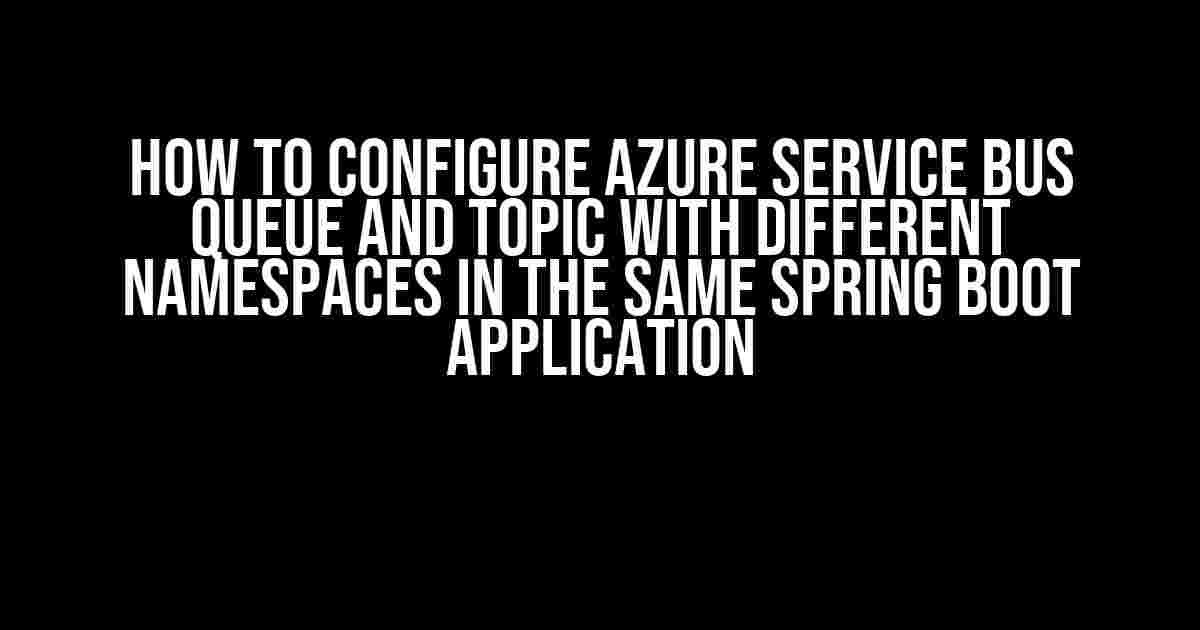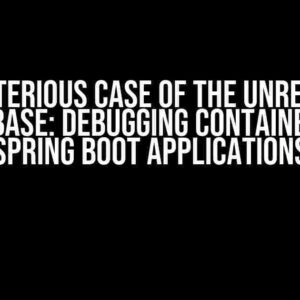If you’re building a Spring Boot application that needs to communicate with multiple Azure Service Bus namespaces, you’ve come to the right place! In this article, we’ll guide you through the process of configuring Azure Service Bus queue and topic with different namespaces in the same Spring Boot application.
Prerequisites
Before we dive into the configuration, make sure you have the following:
- A Spring Boot application with Azure Service Bus starter dependency
- Two or more Azure Service Bus namespaces with queue and topic resources
- Connection strings for each namespace
Understanding Azure Service Bus Namespaces
An Azure Service Bus namespace is a logical grouping of messaging entities like queues, topics, and relays. Each namespace has its own connection string, which is used to authenticate and authorize access to the namespace. In our scenario, we’ll have two namespaces: namespace1 and namespace2, each with its own queue and topic.
namespace1
| Entity | Resource |
|---|---|
| Queue | queue1 |
| Topic | topic1 |
namespace2
| Entity | Resource |
|---|---|
| Queue | queue2 |
| Topic | topic2 |
Configuring Azure Service Bus in Spring Boot
To configure Azure Service Bus in your Spring Boot application, you’ll need to add the Azure Service Bus starter dependency to your pom.xml file (if you’re using Maven) or your build.gradle file (if you’re using Gradle).
<dependency>
<groupId>com.microsoft.azure</groupId>
<artifactId>azure-servicebus-spring-boot-starter</artifactId>
</dependency>Next, create a configuration class to define the Azure Service Bus connections:
@Configuration
public class AzureServiceBusConfig {
@Value("${azure.servicebus.namespace1.connection-string}")
private String namespace1ConnectionString;
@Value("${azure.servicebus.namespace2.connection-string}")
private String namespace2ConnectionString;
@Bean
public ServiceBusAdministrationClient namespace1AdminClient() {
return new ServiceBusAdministrationClient(new ServiceBusClientBuilder()
.connectionString(namespace1ConnectionString)
.buildClient());
}
@Bean
public ServiceBusAdministrationClient namespace2AdminClient() {
return new ServiceBusAdministrationClient(new ServiceBusClientBuilder()
.connectionString(namespace2ConnectionString)
.buildClient());
}
@Bean
public ServiceBusClient namespace1Client() {
return new ServiceBusClientBuilder()
.connectionString(namespace1ConnectionString)
.buildClient();
}
@Bean
public ServiceBusClient namespace2Client() {
return new ServiceBusClientBuilder()
.connectionString(namespace2ConnectionString)
.buildClient();
}
}In the above configuration class, we’ve defined four beans:
namespace1AdminClient: A ServiceBusAdministrationClient instance for namespace1, used for administrative operations.namespace2AdminClient: A ServiceBusAdministrationClient instance for namespace2, used for administrative operations.namespace1Client: A ServiceBusClient instance for namespace1, used for sending and receiving messages.namespace2Client: A ServiceBusClient instance for namespace2, used for sending and receiving messages.
Configuring Queue and Topic Listeners
To listen to messages from queues and topics, you’ll need to create listener classes that autowire the respective ServiceBusClient instances:
@Service
public class Namespace1QueueListener {
@Autowired
private ServiceBusClient namespace1Client;
@EventListener
public void handleQueueMessage(ServiceBusReceivedMessage message) {
// Process message from queue1 in namespace1
}
}@Service
public class Namespace1TopicListener {
@Autowired
private ServiceBusClient namespace1Client;
@EventListener
public void handleTopicMessage(ServiceBusReceivedMessage message) {
// Process message from topic1 in namespace1
}
}@Service
public class Namespace2QueueListener {
@Autowired
private ServiceBusClient namespace2Client;
@EventListener
public void handleQueueMessage(ServiceBusReceivedMessage message) {
// Process message from queue2 in namespace2
}
}@Service
public class Namespace2TopicListener {
@Autowired
private ServiceBusClient namespace2Client;
@EventListener
public void handleTopicMessage(ServiceBusReceivedMessage message) {
// Process message from topic2 in namespace2
}
}Sending Messages to Queues and Topics
To send messages to queues and topics, you can autowire the respective ServiceBusClient instances and use the sendMessage method:
@Service
public class MessageSender {
@Autowired
private ServiceBusClient namespace1Client;
@Autowired
private ServiceBusClient namespace2Client;
public void sendMessageToQueue1(String message) {
namespace1Client.sendMessage("queue1", message);
}
public void sendMessageToTopic1(String message) {
namespace1Client.sendMessage("topic1", message);
}
public void sendMessageToQueue2(String message) {
namespace2Client.sendMessage("queue2", message);
}
public void sendMessageToTopic2(String message) {
namespace2Client.sendMessage("topic2", message);
}
}Conclusion
In this article, we’ve demonstrated how to configure Azure Service Bus queue and topic with different namespaces in the same Spring Boot application. By using separate ServiceBusClient instances for each namespace, we can communicate with multiple namespaces from a single application. Remember to update the connection strings and resource names to match your Azure Service Bus setup.
With this configuration, you can now send and receive messages between multiple namespaces, enabling your application to integrate with various messaging entities in Azure Service Bus.
Here are 5 Q&A about configuring Azure Service Bus queue and topic with different namespaces in the same Spring Boot application:
Frequently Asked Question
Get ready to tackle the challenges of configuring Azure Service Bus queue and topic with different namespaces in the same Spring Boot application!
Q1: How do I configure multiple Azure Service Bus namespaces in the same Spring Boot application?
To configure multiple Azure Service Bus namespaces, you need to create separate `ServiceBusNamespaceManager` beans for each namespace, and then use the `@Qualifier` annotation to inject the correct namespace manager into your service bus clients.
Q2: How do I specify the namespace for an Azure Service Bus queue or topic in a Spring Boot application?
You can specify the namespace for an Azure Service Bus queue or topic by using the `namespace` property in the `@ServiceBusQueue` or `@ServiceBusTopic` annotation. For example, `@ServiceBusQueue(namespace = “my-namespace-1”, value = “my-queue”)`.
Q3: Can I use the same Azure Service Bus connection string for multiple namespaces?
No, you cannot use the same Azure Service Bus connection string for multiple namespaces. Each namespace requires its own unique connection string, which includes the namespace name and a shared access signature (SAS) key or a shared access policy.
Q4: How do I handle errors when communicating with multiple Azure Service Bus namespaces?
To handle errors when communicating with multiple Azure Service Bus namespaces, you can use a global error handler or an error handler specific to each namespace. You can also use retry policies and circuit breakers to handle transient errors and prevent cascading failures.
Q5: Is it possible to use Azure Service Bus Explorer to manage multiple namespaces?
Yes, Azure Service Bus Explorer allows you to connect to multiple namespaces and manage queues, topics, and subscriptions across different namespaces. You can add multiple connections to the explorer and switch between them to manage your Azure Service Bus resources.


